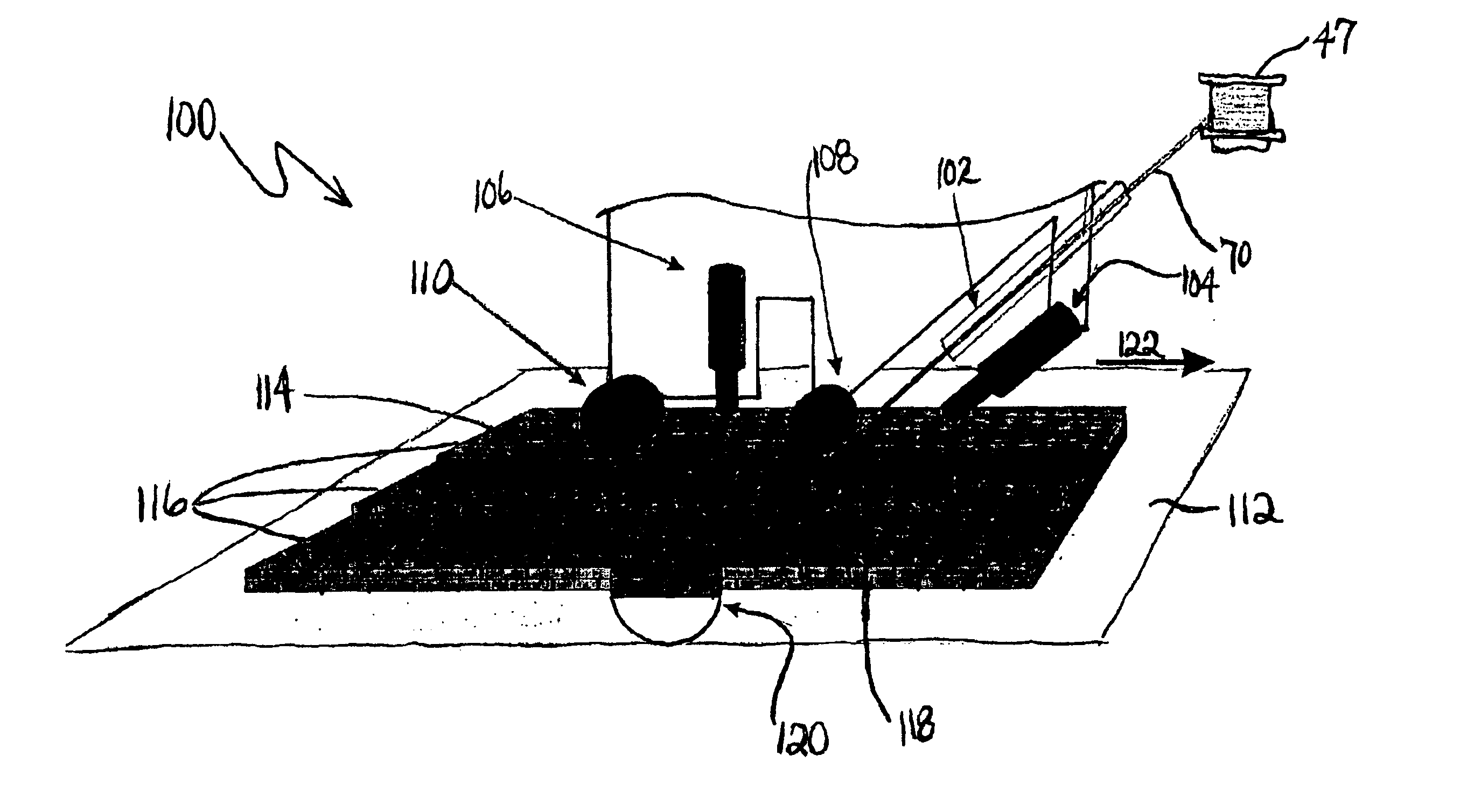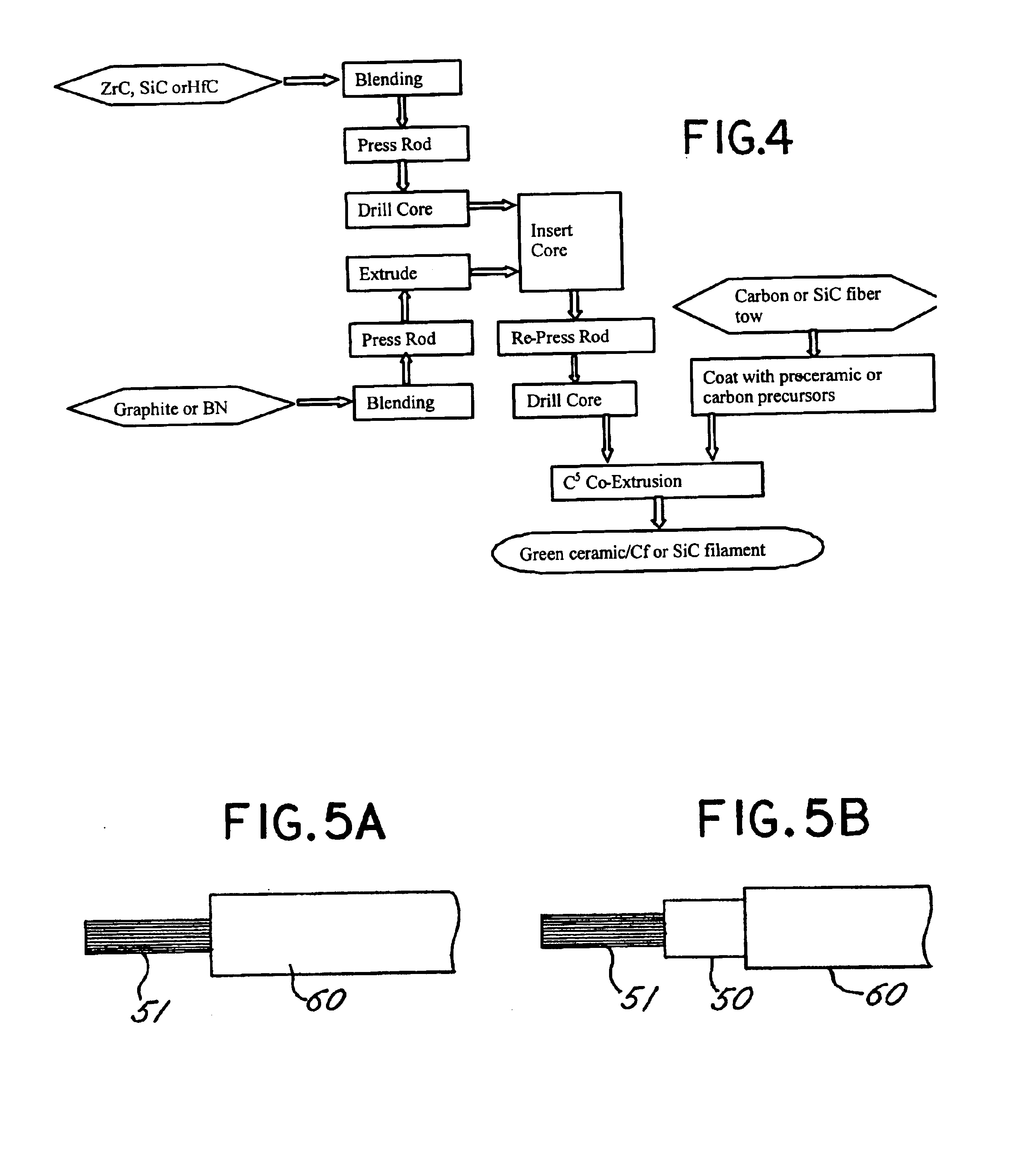Continuous fiber reinforced composites and methods, apparatuses, and compositions for making the same
a technology composites, applied in the field ofcontinuous composites, can solve the problems of limiting the use of fiber reinforced composites in stressed environments, low fracture toughness, and still remain extremely damage-intolerant, and achieves the effects of reducing the temperature of consolidation, facilitating consolidation and bonding of tow and substrate, and easy control
- Summary
- Abstract
- Description
- Claims
- Application Information
AI Technical Summary
Benefits of technology
Problems solved by technology
Method used
Image
Examples
example 1
Hafnium Carbide Matrix / No Interface / Carbon Fiber Reinforcement
[0078]VPCA-BR00[0079]Description: Core Material[0080]Brabender Size: small[0081]Batch Size: 42 cc[0082]Batch Temperature: 150° C.[0083]Batch Speed: 60 rpm[0084]Ingredients:
[0085]
TABLE 3MaterialDensity (g / cc)Volume %Volume (cc)Weight (g)HfC12.6754.0%22.66287.36EEA0.9332.4%13.60812.66B-670.94 3.6%1.5121.42HMO0.88110.0%4.23.70
[0086]In the above-cited formulation of Table 3, HfC is hafnium carbide powder from Cerac, Inc., designated as H-1004, B-67 is acryloid resin from Rohm and Haas, EEA is ethylene-ethyl acetate copolymers, and HMO is heavy mineral oil which is a plasticizer. A “Brabender” mixing machine (from C. W. Brabender of South Hackensack, N.J.) was used to mix the above-cited materials. The mixture of materials can then be formed into a feed rod with a hole through the symmetrical axis of the feed rod. After mixing, the mixture was formed into a feed rod-like shape like that shown in FIG. 1 and in detail in FIG. 3B...
example 2
Hafnium Carbide Matrix / Graphite Interface / Carbon Fiber Reinforcement
[0087]The hafnium carbide matrix made in accordance with Example 1 is the same matrix for Example 2. The only difference in Example 2 is that the hole through the symmetrical axis of the feed rod is made larger so that a graphite interface can be inserted through the hole of the feed rod. The graphite interface defines a hole through its symmetrical axis, and the carbon fiber reinforcement can be inserted into the hole of the graphite interface, resulting in the product illustrated in FIG. 3B. Following coextrusion, desired formation (such as a billet), lamination, pyrolysis, and firing as described in Example 1 and 2 the result is a fully dense composite formation. The formulation for the graphite interface is as follows.[0088]VPCA-BR06[0089]Description: Core Material[0090]Brabender Size: small[0091]Batch Size: 42 cc[0092]Batch Temperature: 150° C.[0093]Batch Speed: 60 rpm[0094]Ingredients:
[0095]
TABLE 4MaterialDens...
example 3
[0098]The present invention can be used to make other reinforcements, including but not limited to:[0099]Zirconium Carbide Matrix / Graphite Interface / Carbon Fiber Reinforcement;[0100]Zirconium Carbide Matrix / No Interface / Carbon Fiber Reinforcement or Silicon Carbide Reinforcement;[0101]Silicon Carbide Matrix / No Interface / Carbon Fiber Reinforcement;[0102]Hafnium Diboride Matrix / Graphite Interface / Carbon Fiber Reinforcement;[0103]Silicon Carbide Matrix / Boron Nitride Interface / Silicon Carbide Reinforcement;[0104]Silicon Nitride Matrix / Boron Nitride Interface / Silicon Carbide Reinforcement;[0105]Silicon Carbide Matrix / Boron Nitride-Sodium Silicate Interface / Carbon Fiber Reinforcement;[0106]Silicon Carbide Matrix / Carbon-Silicon Carbide Interface doped with boron / Carbon Fiber Reinforcement;[0107]Silicon Carbide Matrix / Carbon-Silicon Carbide-Sodium Silicate Interface doped with boron / Silicon Carbide Fiber Reinforcement;[0108]Silicon Carbide Matrix / Boron Nitride-Sodium Silicate Interface / Sili...
PUM
| Property | Measurement | Unit |
|---|---|---|
| force | aaaaa | aaaaa |
| temperatures | aaaaa | aaaaa |
| diameter | aaaaa | aaaaa |
Abstract
Description
Claims
Application Information
 Login to View More
Login to View More - R&D
- Intellectual Property
- Life Sciences
- Materials
- Tech Scout
- Unparalleled Data Quality
- Higher Quality Content
- 60% Fewer Hallucinations
Browse by: Latest US Patents, China's latest patents, Technical Efficacy Thesaurus, Application Domain, Technology Topic, Popular Technical Reports.
© 2025 PatSnap. All rights reserved.Legal|Privacy policy|Modern Slavery Act Transparency Statement|Sitemap|About US| Contact US: help@patsnap.com



